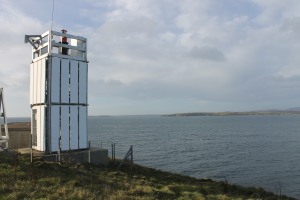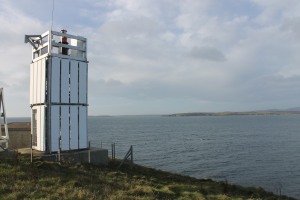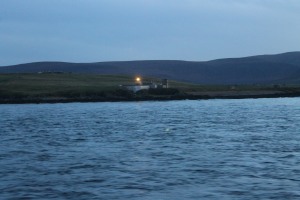To begin with I have two factual pieces of information for you: 1. As I am sure you will know there is currently flooding in a number of parts of the country and 2. Wikipedia currently states that Wales is “one of the wettest countries in Europe”. So, on a rather damp Thursday evening last week Bob and I happened to be travelling to no less than South Wales. Gluttons for punishment you may be thinking, but we were in fact rather surprised to find that, after crossing the bridge on the M4 and entering Wales (£6 it costs these days to enter Wales via this route – that was, to my mind, essentially paying to be rained on and seemed deeply unfair) the very wet weather we had encountered in “Englandshire” (as Bob fondly – or not so fondly – refers to it) had almost vanished. Amazing! This surprised continued well into Friday, which was dry from beginning to end with blue skies.
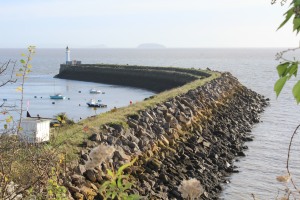
Unfortunately, our luck on Friday morning was clearly reserved for the weather as Barry Docks, the first lighthouse location, wasn’t particularly successful. Without a fair amount of clambering over rocks on the breakwater or knowing someone who can gain access to the local yacht club then it is almost impossible to truly “bag” this lighthouse. This may be have been the location of the first of many where the immortal “We need a boat” was used – it is becoming more frequently used it seems. We had a little stroll along the small beach nearby though and I almost got swept away by a wave (n.b. this is a major exaggeration, but a wave did almost reach my feet).
Next up was Nash Point with its old and new lighthouses. This was more successful, although the lighthouse was not open to look around until the following day. Before we reached the lighthouse though, Bob had a field day with the muddy road/wrong turning we took and made it his aim to get as much mud as possible splattered all over the hire car, a powder blue Fiat 500. We had a bit of chuckle about the state of it when we arrived at Nash Point. Between the two lighthouses, one of which no longer has its lantern, is a building with the foghorn mounted on top. This and the very tall new lighthouse create a rather picturesque scene. After leaving Nash Point we stopped off for some soup in a nearby pub (there may have been blue skies, but it was rather chilly).
The Mumbles was our next stop. I realised before we headed for Wales that it wouldn’t be possible to visit this one as it sits on top of a very small island a short distance off of the coast and that day’s low tides don’t even provide access. We could see it and the scaffolding is currently has draped over it very clearly from the mainland though.
We questioned whether or not to attempt to see Whiteford Point lighthouse from the north side of the Gower Peninsula. I am fascinated by this lighthouse as it’s probably the most derelict in the whole of the UK – as far as I have seen anyway. It is essentially just the metal frame of the structure and has been on sale for very small amounts in the past without success. Viewing the lighthouse though was potentially very tricky with sand dunes and potential marshland to deal with. We decided instead to see if we could catch a glimpse of it from the north, near Llanelli where we were heading to see the lighthouse at Burry Port.
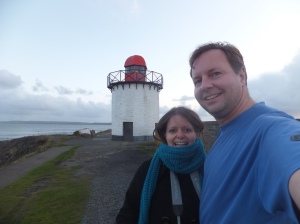
Burry Port is a strange place with a bit of an old-world feel about it, but it has a really lovely lighthouse on the end of the west pier. It was getting later in the day and the light was beginning to fade so we were able to enjoy her in action. I must admit here to being a bit of a child at times and, as we walked towards the lighthouse after catching some distance shots of Whiteford Point lighthouse, I may have said ‘flashy’ every time it flashed. My only excuse is that I really liked the lighthouse and how it’s a little unconventional!
We headed to Fishguard on Friday evening to prepare for an early start on Sunday, ensuring we made the most of the rain-free hours leading up to the downpours that had been forecast from midday. We stayed the night in a small B&B called Keating’s B&B in the Goodwick area, just west of Fishguard town. The following morning we headed off for Fishguard breakwater to see if we could access the lighthouse at the end. We were without luck on this occasion as, for a change, Bob had a bad feeling about trespassing in the area. I didn’t realise that was possible!
We headed next to Strumble Head, just west of Fishguard. On the way there I got (jokingly) grumpy as Bob spotted the lighthouse before I did – he’s getting too good at this, I think. It wasn’t surprising though as it has possible the brightest light I have ever seen on a lighthouse. It would flash four times in quick succession and trying to get a photo of this sequence each time it flashed would leave your eyes feeling a little funny. It’s a really beautiful lighthouse though, although access to the island it sits on is restricted. I would definitely recommend a visit to this one for those who find themselves in the area.

On our way to our next stop for the day, St Anne’s Head, the rain began and was relentless. We ploughed on through though, with Bob getting increasingly pleased with the growth in the size of the puddles in the roads. Apparently aquaplaning is exciting! There are two lighthouses at St Anne’s Head, although one has had the lantern removed and replaced with an observation room. We dashed about in the rain and got the very important pictures before returning to the dry and warmth of the girly Fiat (which Bob could pull off because of his manly physique)!
We had seen a leaflet back in Fishguard about the Pentre Ifan Cromlech burial ground which has some fascinating standing stones – one 16 tonne stone is balanced on top of three equally huge stones. So, we headed north again, stopping briefly at a café for some much-needed lunch. The stones were just as amazing in real life as in the pictures. They are located on the side of a hill as well, which allows for some great views too. The location is a little out of the way, but well worth a visit.
Bob had mentioned an Italian restaurant he had been to a few times in a town called Blackwood, so we headed there for the night. The food was great and it’s definitely understandable why he felt it was important for us to pay them a visit. Finding accommodation though wasn’t particularly easy, but we opted for a place on the main street, which looked like a pub with a few rooms upstairs. However, it turned out to double up as a club with the rooms only separated from the club area by a few walls. We went with it though and threw a film on to drown out the music. We were only woken once during the night by a screaming girl and, it turns out, the screaming Welsh female voice is not really one that is comprehensible to me – fortunately. We made it through though and set off for our final day on Sunday morning.
On Sunday morning we stopped off at Caerphilly Castle, which amazed me as the moat was actually filled with water. As far as I’m aware, that’s rather rare these days. It was absolutely stunning and we got some great photos before the rain started and we made a mad (or not so mad) dash back to the car.
Luckily the rain had stopped by the time we reached our penultimate lighthouse location on the west side of the Usk. This one was a struggle and I’m not sure that either of us found it worth the effort in the end. To reach the lighthouse we parked up in an area with lots of places with ‘lighthouse’ in the name, so it was probably not going to be far. After probably around 40 minutes of making our way across some very marshy land it turned out it wasn’t quite as close as expected. It wasn’t really an enjoyable journey, but we did find a more suitable route back, which halved the journey time at least.

Our final stop before heading back to England was the east side of the Usk. This lighthouse was located in a RSPB reserve and actually involved a shorter walk than we thought it would. To reach the lighthouse we could walk across a path that stretched over the top of a river. The path itself was made of some form of rubber material on top of floating buoys, which Bob really enjoyed jumping around on (we were basically children all weekend)! Seeing the final Welsh mainland lighthouse, which is rather cute and reminiscent of the recently-visited Roseness lighthouse on Orkney mainland – gave me a small sense of achievement. I even got the opportunity to slide down from the top of a lighthouse in the children’s play area before we left.
All in all, a very successful weekend and a really enjoyable one too! So that’s it for mainland Wales. We are edging ever closer to completion of the mainland lights! 🙂

